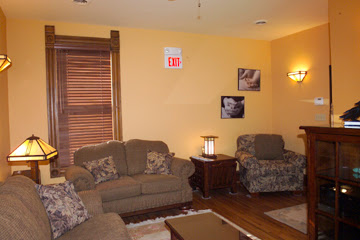Freestanding birth centers often advertise that they are the "best of both worlds." For example, the Connecticut Childbirth and Women's Center states that "the birthcenter provides women with the best of both worlds--expert care provided by certified nurse-midwives, while emergency care is just a stone throw away" at the nearby hospital. I've often wondered about freestanding birth centers. I think they are fantastic for women who have a need to birth in some kind of institution (whatever that need might be: mental, emotional, lack of a safe home environment) but don't want the whole hospital runaround. I wish that there were more birth centers, so that it would be an option for any woman who desired it.
However, in light of some of the discussion about the photo essay about "homelike" birthing spaces, I'd like to offer up another view of birth centers as the worst of both worlds. Here's why:
Freestanding birth centers offer no technological or pharmacological advantages over home births. Midwives in both settings carry nearly identical equipment. It might vary slightly from midwife to midwife, of course, but there is no additional technology available in FSBC's compared to midwife-attended home births. In both settings, women will likely have access to:
- anti-hemorrhagic treatments and equipment (ranging from herbal tinctures to Pitocin, Methergine, Cytotec, IVs to replace fluid loss and/or stablize in case of transport)
- maternal and neonatal resuscitation equipment and skills (bag & masks, oxygen tanks, suctioning equipment, possibly meds & intubation supplies)
- suturing equipment and local anesthetic
- fetoscopes/dopplers for listening to baby's heart beat during labor
- other equipment for monitoring vital signs (BP cuff, stethoscope, thermometer, etc)
Women in both settings will need to transfer to a hospital for interventions such as:
- operative deliveries (vacuum extraction, forceps, cesarean section)
- analgesia (except in rare cases where some birth centers supply IM narcotics)
- anesthesia (spinal, epidural, etc)
- continuous Electronic Fetal Monitoring (external or internal)
- blood banks if a transfusion is needed
In a home birth, a woman is on her own turf. The midwife is the invited guest. In a FSBC, however, it is the midwife's turf. Often birth centers have a set of protocols that govern when a woman must transfer to a hospital or to OB care. The midwife at the birth center has final say over whether or not the woman can use the facilities. Like Tabitha and others have commented, no matter how nice the decor, it isn't the same at someone else's place. You don't usually feel the same sort of liberty or comfort or lack of inhibition as you would in your own space.
So perhaps birth centers are the worst of both worlds. There is no additional safety or access to technology in a freestanding birth center compared to home, and the woman is not on her own turf and ultimately cannot make the final decisions of when to stay or transport like she could at home.
Thoughts on this?
Read more ...
However, in light of some of the discussion about the photo essay about "homelike" birthing spaces, I'd like to offer up another view of birth centers as the worst of both worlds. Here's why:
Freestanding birth centers offer no technological or pharmacological advantages over home births. Midwives in both settings carry nearly identical equipment. It might vary slightly from midwife to midwife, of course, but there is no additional technology available in FSBC's compared to midwife-attended home births. In both settings, women will likely have access to:
- anti-hemorrhagic treatments and equipment (ranging from herbal tinctures to Pitocin, Methergine, Cytotec, IVs to replace fluid loss and/or stablize in case of transport)
- maternal and neonatal resuscitation equipment and skills (bag & masks, oxygen tanks, suctioning equipment, possibly meds & intubation supplies)
- suturing equipment and local anesthetic
- fetoscopes/dopplers for listening to baby's heart beat during labor
- other equipment for monitoring vital signs (BP cuff, stethoscope, thermometer, etc)
Women in both settings will need to transfer to a hospital for interventions such as:
- operative deliveries (vacuum extraction, forceps, cesarean section)
- analgesia (except in rare cases where some birth centers supply IM narcotics)
- anesthesia (spinal, epidural, etc)
- continuous Electronic Fetal Monitoring (external or internal)
- blood banks if a transfusion is needed
In a home birth, a woman is on her own turf. The midwife is the invited guest. In a FSBC, however, it is the midwife's turf. Often birth centers have a set of protocols that govern when a woman must transfer to a hospital or to OB care. The midwife at the birth center has final say over whether or not the woman can use the facilities. Like Tabitha and others have commented, no matter how nice the decor, it isn't the same at someone else's place. You don't usually feel the same sort of liberty or comfort or lack of inhibition as you would in your own space.
So perhaps birth centers are the worst of both worlds. There is no additional safety or access to technology in a freestanding birth center compared to home, and the woman is not on her own turf and ultimately cannot make the final decisions of when to stay or transport like she could at home.
Thoughts on this?






































